|
| |
| |
| |

fig. 1
Claude Monet, Mills at Westzijderveld near Zaandam, 1871, Amsterdam, Van Gogh Museum
| |
| |
| |
Review August 2000 - July 2001
Introduction
The year 2000 brought a new record in the number of visits to the Van Gogh Museum. A total of 1,312.204 visitors made their way through our doors last year, an increase of almost 30 percent from the previous record year in 1997 (the Museum was closed for renovation during part of 1998 and 1999). While elsewhere in the Netherlands visitor numbers to museums have either remained stable or in some cases even decreased, the Van Gogh Museum has witnessed a pattern of steady growth.
The museum has of course benefited from the general trends in tourism, and Amsterdam has maintained its popularity with overseas visitors. The seemingly unremitting publicity surrounding various aspects of Van Gogh's life and art has also helped attract attention to our activities. But, setting the cloak of modesty to one side for a moment, there is plenty of evidence to suggest that the increasing popularity of the museum results in large measure from the appeal of our programmes and our success in bringing them to a wider audience. With the new wing, opened in 1999, we have been able to further develop our exhibition programme. Our surveys show that an increasing number of visitors are not restricting their visits to the permanent collection but are also coming for the temporary shows. Our educational service has also expanded, with a resulting increase in schools visits, while new acquisitions have also helped to generate interest, especially among the local public.
Needless to say, the increasing number of visitors has brought with it challenging logistical problems and added to the pressure of work for our staff. In recent years our organisation has become steadily more professional in its approach to running a modern, public-friendly facility. In February 2001 the management team was further strengthened with the appointment of Ruth Kervezee as Director of Internal Affairs. Previously one of the directors of the Dutch section of Médecins sans Frontières, Ms Kervezee brings her considerable administrative experience in the not-for-profit sector to the Van Gogh Museum. Our former Deputy Director, Ton Boxma, has been appointed Director of Van Gogh Museum Enterprises Ltd., a new company established in 2000 to develop the museum's commercial activities.
The Van Gogh Museum, like so many other museums across the world, has had to respond to the shifting economic, social and political environment. However, as the contents of this issue of the Van Gogh Museum Journal demonstrate, our focus remains firmly on the time-honoured activities of a museum: caring for and developing the collection; pursuing scholarship of the highest standards; and using the collection to inform and inspire a broad public both here in the Netherlands and abroad. The continuing popularity of the museum suggests that our public is happy to endorse this approach.
| |
The collection
In recent years our acquisitions policy has become more focused on filling specific gaps in the museum's presentation of 19th- and early 20th-century art. Whereas for many years the emphasis was on marking out new areas of collecting - such as symbolism or academic art - our aim now is to build upon what has already been achieved and, wherever possible, to marshal our resources towards acquiring major works. In contrast to the high quality of the Van Gogh collection, our representation of 19th-century art remains uneven. Our biggest challenge is now to redress this balance.
One of the major failings of our displays has always been its lack of a satisfactory overview of impressionism. This year, however, we were fortunate to be able to acquire our first significant impressionist paintings. For some time we had been looking for a good example of Monet's work from the 1870s, preferably depicting a Dutch subject. When by coincidence two such pictures became available we decided to make an effort to acquire both. One is an important canvas from the artist's first trip to Holland in 1871, when he stayed at Zaandam; the other is a view of Amsterdam painted a few years later. Both reproduce subjects
| |
| |
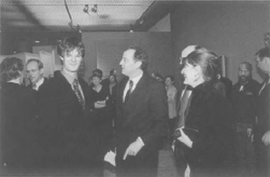
fig. 2
Secretary for culture, Rick van der Ploeg and the mayor of Amsterdam, Job Cohen, at the unveiling of the newly acquired Monet paintings
many local residents will recognise, and they well illustrate Monet's fascination with Holland's particular light and atmosphere (see also pp. 140-43). Together the two paintings make a compelling pair, showing the development of Monet's style and approach in the crucial early years of impressionism.
The purchase of two pictures by Monet in one fell swoop was only possible thanks to important developments in the funding of museum purchases in the Netherlands. Until recently, the Van Gogh Museum had only relatively modest sums at its disposal when adding new works to the collection. In 1998, however, the Van Gogh Museum - along with the Rijksmuseum, the Mauritshuis and the Kröller-Müller Museum - became a beneficiary of the Dutch Sponsor Lottery (now renamed the Sponsor Bingo Lottery). Funds provided by the lottery had already contributed to the purchase of a major work by Kees van Dongen, The blue dress (see Van Gogh Museum Journal 1999).
Several other trusted supporters of the museum world helped in making these acquisitions possible, including the Vereniging Rembrandt (supported by the Prins Bernhard Cultuurfonds and a donation from VNU), the Mondriaan Stichting and the VSB-Fonds. The state also did its part with a donation from the National Acquisitions Fund. But it was a relative newcomer that played the key role in raising the capital for the purchases, the Nationaal Fonds Kunstbezit. A total of seven major Dutch companies donated monies for the works through this new national fund: ABN AMRO, ING, Fortis, Shell, Unilever, Heineken and Philips Electronics. This is the first time in recent history that heavyweights from the Dutch business world have joined together to support a purchase for a museum's permanent collection. It is to be hoped that this initiative will be the start of a new phase in the enrichment of museum collections across the country.
Alongside our acquisitions we rely heavily on loans from museums and private collections to bolster our displays. At present we have works on loan from the Rijksmuseum, the Stedelijk and Amsterdams Historisch Museum, the Museum of Fine Arts in Boston and the National Gallery in London. The most significant new loan in the past year was of a magnificent work by Alfred Sisley from a private collection, Effet de neige à Argenteuil. As in previous years we have ourselves lent generously to exhibitions both here in the Netherlands and abroad.
| |
Exhibitions
Exhibitions play a major role in our efforts to attract a broad public and in particular to reach a local and national audience. In October 2000 we opened what was possibly the most ambitious exhibition ever held at the Van Gogh Museum, and certainly one of the largest and most successful: Light! The Industrial age, 1750-1900. Art and science,
| |
| |
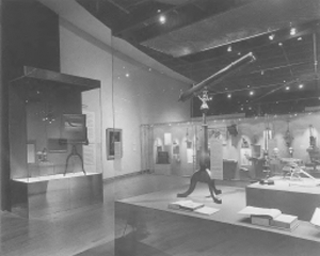
fig. 3
Light! Installation in the new wing
technology and society. The response both in the Netherlands and abroad was enthusiastic; it seems that the multidisciplinary approach of the show appealed to visitors both young and old, attracting a wider audience than one would normally expect for an art exhibition.
In his review of Light! in The Burlington Magazine, John Gage commented: ‘[...] it is difficult to summarise the scope and excitement of this extraordinary exhibition [...].’ The show followed developments in the technology of light and the science of optics in the crucial period from the beginning of the industrial revolution to the end of the 19th century. Using over 300 exhibits and a number of specially constructed experiments, the curators set out to show how changes in the use of both real and artificial light had a dramatic affect on all aspects of life: from street lighting to warfare and from medicine to home entertainment. Central to the show, of course, was an exploration of the impact of new technology on art and artists, whether it was the increasing fascination with light apparent in the work of 18th- and early 19th-century artists from Wright of Derby to Turner, or the developing sensitivity to different kinds of outdoor light evident in the work of the pre-Raphaelites or the impressionists.
The show itself made full use of modern technology with a number of imaginative displays. On the way into the main rooms visitors were guided through a ‘time tunnel,’ in which sound and projection was used to recreate an Amsterdam street as it would have been lit at different moments in its history, from 1780 until the present. Elsewhere, Van Gogh's Gauguin's chair was displayed under four different kinds of illumination: daylight, an open gas flame, gaslight with mantle, and an arc light. Displays like this clearly demonstrated that 18th- and 19th-century artists experienced their works in quite a different light from the modern viewer. Perhaps most important, however, the exhibition challenged the public to open their eyes and appreciate a phenomenon that is normally taken for granted.
Light! was a collaborative effort between the Van Gogh Museum and the Carnegie Museum of art in Pittsburgh. A catalogue, written by the exhibition's curators Andreas Blühm, Head of Exhibitions at the Van Gogh
| |
| |
Museum, and Louise Lippincott, Curator of Fine Art at the Carnegie Museum of Art, and published by Thames and Hudson, accompanied the show. A CD-Rom with four interactive light experiments, produced by VLM Computer Graphics was also available.
It was only appropriate that Light! should have been followed by Impression: painting quickly in France, 1860-1890. This exhibition aimed to restore something of its original visual shock and excitement to impressionist art. It focused on a type of painting which, curiously enough, has often been overlooked in recent surveys of the movement, but which was at the heart of the impressionist venture: those rapidly painted works, arrogant in their casualness and directness, which Monet, Renoir and others nonetheless considered worthy of exhibition and sale.
The main protagonists of the show were Manet, Monet, Morisot, Sisley and Renoir. A few experiments in ‘painting quickly’ by Degas and Pissarro were also included. The exhibition highlighted the deliberate rawness, speed and dramatic gestures of these artists' works as they strove to capture a world in a state of flux. There were paintings of sunsets, of trains, of gusts of wind, of freshly cut flowers - all subjects that were short-lived and demanded the artist work in a form of pictorial shorthand, evolving a new painterly language of slashing, smearing and dotting with paint. The exhibition was organised by the Sterling and Francine Clark Art Institute in collaboration with the Van Gogh Museum and the National Gallery in London. The catalogue was written by guest curator Richard R. Brettell and published by Yale University Press.
The Van Gogh Museum continued its series of exhibitions exploring aspects of 19th-century photography with a show devoted to the American Fred Holland Day (1864-1933). Although hailed as a leading talent during his own lifetime, Day's work has only rarely appeared in exhibitions or been featured in publications. The photographs are remarkable enough in terms of technique, with their striking manipulations of light, tone and texture. But it is the subject matter that singles Day out as an extraordinary figure of the fin de siècle. His pictures include naked youths in an array of introverted, dream-like poses, and a series in which he depicts himself as Jesus Christ. The exhibition was organised with the Royal Photographic Society in Bath and was also shown at the Museum of Fine Arts, Boston and the Museum Villa Stuck in Munich. The show was accompanied by a handsomely designed and produced book entitled F. Holland Day, compiled by the exhibition's curator at the Van Gogh Museum, Edwin Becker, in collaboration with Pam Roberts, Verna Posever Curtis and Anne E. Havinga.
The summer exhibition at the Van Gogh Museum was a major retrospective of the work of Paul Signac. Along with Georges Seurat, Signac was a leading figure in the development of neo-impressionism, one of the most influential movements in avant-garde art in the last decades of the 19th century. Signac played a central role in ensuring that the style took hold not just in France but also in several European countries, including Belgium, the Netherlands and Germany.
The exhibition was the first major retrospective of the artist's work in almost 40 years and was organised in collaboration with the Musée d'Orsay in Paris and The Metropolitan Museum of Art in New York. The show followed Signac's development from his first tentative exercises in outdoor painting, closely modelled on the impressionists, to the amazing colouristic fireworks of his last paintings, which verge on abstraction. An impressive array of neo-impressionist landscapes formed a centrepiece of the show. The artist's later oeuvre was also well represented. A group of works on paper from the impressive collection donated by to the Arkansas Arts Center in Littlerock by James Dyke helped create a superb display of Signac's achievements as a watercolorist. The catalogue is available in two versions, in French published by the Réunion des Musées de France, and in English by The Metropolitan Museum of Art; it includes contributions by myself, Anne Distel, Sjraar van Heugten, Susan Stein and Marina Ferretti.
| |
Future project: Van Gogh 150
The year 2003 will mark the 150th anniversary of the birth of Vincent van Gogh. Among the activities planned to celebrate this occasion is a special exhibition entitled Vincent's taste. It will explore Van Gogh's preferences in art and literature, using a thematic approach to reveal the development of his highly individual likes and dislikes. Works that were of special significance for the painter will be shown alongside major pieces by Van Gogh himself, illustrating how his taste for the art of others came to be reflected in his own oeuvre. An extensive catalogue written by experts at the Van Gogh Museum will accompany the show.
| |
| |
| |
Research
Since 1 April 2001 Chris Stolwijk has been Head of Research at the Van Gogh Museum. All scholarly research within the collections department is now carried out under his supervision, with the aim of increasing collaboration and contact between the various research projects now underway. One of the major tasks of the Head of Research to foster links with museums, universities and other outside institutions active in our subject area.
There are two long-term projects that are central to the museum's research programme: the production of a series of catalogues of our Van Gogh collection, and a new edition of the artist's letters. Work began on the eight collection catalogues in 1995 and three have since been published: two volumes on the drawings (until 1885) and one on the early paintings. The second volume of paintings, from Antwerp and Paris periods, will be published in 2003. The third volume of drawings, covering the same time-frame, was published in September of this year, coinciding with an exhibition of the museum's entire holdings in this area. The authors, Marije Vellekoop and Sjraar van Heugten, have produced extensive entries for 120 drawings. While there is detailed information on each individual sheet, the authors have also paid special attention to the evolving style and thematic developments in Van Gogh's drawings during his sojourn at the Antwerp academy and at the studio of Fernand Cormon in Paris. They have also addressed the problems of dating and attribution - a number of works in the collection have now been re-attributed to other artists.
This cataloguing project is supported by Shell Netherlands. Shell has provided invaluable assistance with the technical analysis of paintings and the project has benefited enormously from the time and expertise of specialist staff at this company.
Our second major undertaking is the creation of a new scholarly edition of Van Gogh's complete correspondence, with revised texts, new English translations and comprehensive annotations. This project began in 1994 in cooperation with the Constantijn Huygens Institute in The Hague. Originally, it was hoped the venture would be completed within five years, but the work involved has been much more time-consuming than anticipated and the publication date has now been pushed back to 2008. New and fully accurate transcriptions of all the Van Gogh correspondence housed at the museum have now been completed and annotations have been prepared for over 300 letters. Over the following years work will continue on the annotations and the English translation. The research carried out by the ‘letters team’ continues to provide a steady stream of new insights into the work of Van Gogh. The deciphered fragment of a letter published in last year's Van Gogh Museum Journal was one of the centrepieces in a small display in the Rietveld building in the summer of 2001.
Over the years the museum has produced a series of publications entitled Cahier Vincent, devoted to various aspects of the research into Van Gogh's life and oeuvre. Work has now been completed on the eighth volume in the series, on the so-called ‘account book’ kept by Theo van Gogh and his wife Johanna van Gogh-Bonger. This ledger offers valuable glimpses into their dealings and includes information about the sales of certain works. The volume will be published in 2002.
| |
Education
Education remains a high priority at the Van Gogh Museum and we now offer a wide range of information and explanatory material to meet the varying demands of our public. In recent years particular emphasis has been placed on developing an imaginative and stimulating programme for schools. The education department has made great progress in evolving material and activities that match the needs of particular levels in the primary and secondary school curricula, working in close consultation with teachers and experts in the field. Demand has risen as the word spread about the museum's new services and visits from schools have almost doubled in over the last year. For the first time, the Van Gogh Museum participated in the biennial Educational Fair in Utrecht, a national event that helped raise the profile of the education department and to draw attention to its activities.
The exhibition Light! provided the stimulus for one of the museum's most extensive educational projects to date. Teacher's packs, a special newspaper and a diversity of course material was developed in cooperation with the local educational foundation, Kunstweb. The interdisciplinary nature of the show - with its emphasis on the links between art, science and technology - made a superb starting point for tours and workshops. The demonstrations of 19th-century lamps and lights provided by Stichting EnergeticA (a museum of energy technology in Amsterdam) proved particularly popular.
| |
| |
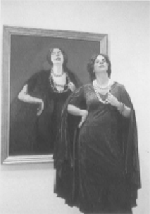
fig. 4
Actress Yvonne Kuhfus as Augusta van Dongen
Alongside the more familiar teaching aids, there have also been some striking innovations. The painting The blue dress by Kees van Dongen (a portrait of the artist's wife, Augusta) was the starting point for a project aimed at children between the ages of six and eight. Following an introductory lesson at their school, pupils arrived at the museum to be greeted by Augusta herself, dramatically clad in the costume in which she appears in the painting. Having accidentally stepped out of her picture, Augusta is now lost and the children are asked to help her regain the safety of her frame before the museum opens to the public. Along the way she stops to tell them about various works of art. The response to this presentation was hugely enthusiastic and the programme will be extended into 2002.
The museum has also responded to government initiatives designed to encourage closer cooperation between schools and cultural institutions, as well as to reach out to new, multicultural audiences. The Van Gogh Museum is currently participating in a joint project with the Stedelijk Museum, the Amsterdams Historisch Museum and the Rijksmuseum to develop a programme for students in the new VMBO course (pre-vocational secondary education with an emphasis on such fields as technology, agriculture and engineering). These are pupils who might otherwise be less exposed to culture in general and museums in particular, and the venture presents numerous challenges. This is the first time Amsterdam's art museums have joined forces to provide a special educational service.
In addition to these continuing programmes the museum organises intermittent special events. In the period under review two such occasions are worthy of particular mention. On 11 November 2000 the Van Gogh Museum participated in Amsterdam's first ‘Museum Night.’ All the museums in the city remained open until late in the night, offering a host of special activities. A flood of visitors came to the Van Gogh Museum to visit the collections, the special exhibition Light! and to hear live jazz music. Another popular event was a special lecture given by British artist David Hockney on 2 February 2001. Hockney talked on what he describes as ‘secret knowledge,’ proposing that in the past, artists made far greater use of lenses and mirrors in their art than has previously been acknowledged.
| |
Van Gogh Museum website
The museum's website (www.vangoghmuseum.nl) has been further expanded to include information on more works from the collection. The most spectacular recent addition, however, was the inclusion of a virtual tour. Visitors can now wander through a three-dimensional reconstruction of the Van Gogh displays at the museum, zooming in on particular works and examining them in detail. The visual experience is backed up with plenty of written material, while two works, The yellow house and The bedroom are
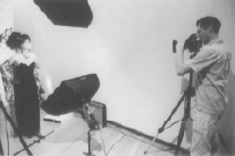
fig. 5
Visitors during Museum Night, 11 November 2000, being photographed by Dutch photographer Erwin Olaf
| |
| |
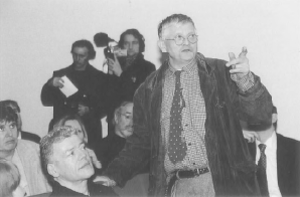
fig. 6
David Hockney lecturing at the Van Gogh Museum, 2 February 2001
the subject of detailed study. Thanks to the wonder of the new technology, it is even possible to step inside the artist's bedroom and to contemplate aspects of this work, as it were, from inside out.
| |
Museum Mesdag
The Van Gogh Museum took over the management of the Museum Mesdag in 1990 and, after a major renovation, our sister museum in The Hague reopened to the public in 1996. This important collection of paintings and drawings (mainly of the Barbizon and Hague Schools) has been described as one of the best-kept secrets in the Dutch museum world. Visitors are generally enthusiastic about the presentation of the collection in the authentic atmosphere of a late 19th-century town house, with paintings vying for attention with decorative art objects, tapestries and Japanese sculptures. It would be fair to say, however, that visitor numbers have been disappointing and that this gem of a museum deserves a wider audience.
In May 2001 Maartje de Haan was appointed to the new post of Curator/Manager of the Museum Mesdag. Formerly a curator in the print room at the Museum Boijmans van Beuningen in Rotterdam, Ms De Haan now has the task of developing a new programme of activities for the Museum Mesdag, centred upon a number of small temporary exhibitions each year. The first aim is to build up a loyal audience within the local area. More will be done to attract school visits and to increase cooperation with the other museums in The Hague, particularly the popular Panorama Mesdag, housed in a neighbouring street. The first such display, featuring photographs by Hans van de Boogaard of the interiors of various artist's houses and studios, opened in June 2001 and the exhibition Summer in Mesdag, featuring sun-filled paintings by Hague school artists, opened on 17 August.
| |
Attendance figures
In the year 2000 the Van Gogh Museum attracted 1,312.204 visitors. From 1 January to 26 August 2001 the museum has received 925,524 visitors. A total of 6,208 people visited the Museum Mesdag in 2000 and from 1 January to 26 August 2001 it has received 4,433 visitors.
John Leighton
Director
|
|